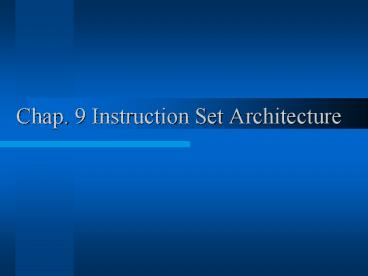Chap' 9 Instruction Set Architecture - PowerPoint PPT Presentation
1 / 21
Title:
Chap' 9 Instruction Set Architecture
Description:
Provide either a memory address or an address for selecting a processor register ... CISC (Complex Instruction Set Computer) Architectures ... – PowerPoint PPT presentation
Number of Views:41
Avg rating:3.0/5.0
Title: Chap' 9 Instruction Set Architecture
1
Chap. 9 Instruction Set Architecture
2
Computer Architecture Concepts
- Instruction format
- Opcode field
- Specify the operation to be performed
- Address field
- Provide either a memory address or an address for
selecting a processor register - Mode field
- Specify the way the address field is to be
interpreted
3
Computer Architecture Concepts
- Basic computer operation cycle
- Fetch the instruction from memory into a control
register - Decode the instruction
- Locate the operands used by the instruction
- Fetch operands from memory (if necessary)
- Execute the operation in processor registers
- Store the results in the proper place
- Go back to step 1 to fetch the next instruction
4
Computer Architecture Concepts
- Register Set
- All registers in the CPU that are accessible to
the programmer - Mentioned in assembly lang.
- cf) register file for ?-program, pipeline
registers - Ex)
- Processor status register (PSR)
- C, N, V, and Z from ALU
- Stack pointer (SP)
5
Operand Addressing
- Fetching operand within instruction
- Implied address vs. explicit address
- The number of explicitly addressed operands per
instruction - Three-address instructions
- Two-address instructions
- One-address instructions
- Zero-address instructions
long instructions
Many steps of executions
6
Operand Addressing
- Three-address Instructions
- Memory-to-memory architecture
- Ex) X(AB)(CD)
- ADD T1, A, B MT1?MAMB
- ADD T2, C, D MT2?MCMD
- MUL X, T1, T2 MX?MT1MT2
- ADD R1, A, B R1?MAMB
- ADD R2, C, D R2?MCMD
- MUL X, R1, R2 MX?R1R2
7
Operand Addressing
- Three-address Instructions
- register-to-register (load/store) architecture
- Allow only one memory address
- load, store instructions
- Ex) X(AB)(CD)
- LD R1,A R1?MA
- LD R2,B R2?MB
- ADD R3,R1,R2 R3?R1R2
- LD R1,C R1?MC
- LD R2,D R2?MD
- ADD R1,R1,R2 R1?R1R2
- MUL R1,R1,R3 R1?R1R3
- ST X,R1 MX?R1
8
Operand Addressing
- Two-address Instructions
- Ex) X(AB)(CD)
- MOVE T1, A MT1?MA
- ADD T1,B MT1?MT1MB
- MOVE X,C MX?MC
- ADD X,D MX?MXMD
- MUL X,T1 MX?MXMT1
- If register-memory architecture
- ADD R1,A R1?R1MA
9
Operand Addressing
- One-address Instructions
- Single-accumulator architecture
- A special register called accumulator for
obtaining one of the operands and as the location
of the result - Ex) X(AB)(CD)
- LD A ACC?MA
- ADD B ACC?ACCMB
- ST X MX?ACC
- LD C ACC?MC
- ADD D ACC?ACCMD
- MUL X ACC?ACCMX
- ST X MX?ACC
10
Operand Addressing
- Zero-address Instructions
- Stack architecture
- Ex) X(AB)(CD)
- PUSH A TOS?MA
- PUSH B TOS?MB
- ADD TOS?TOSTOS-1
- PUSH C TOS?MC
- PUSH D TOS?MD
- ADD TOS?TOSTOS-1
- MUL TOS?TOSTOS-1
- POP X MX?TOS
11
Stack architecture
- Processing expressions
- Postfix expression
- reverse Polish notation (RPN)
- Ex) (AB)C(DE) ? A B C D E
3
1
2
12
Stack architecture
- Program for evaluating A B C D E
- PUSH A
- PUSH B
- ADD
- PUSH C
- MUL
- PUSH D
- PUSH E
- MUL
- ADD
13
Addressing Modes
- Implied mode
- Immediate mode
- Register and register-indirect mode
- Direct addressing mode
- Indirect addressing mode
- Relative addressing mode
- Indexed addressing mode
- Base-register mode
14
Addressing Modes
- Implied mode
- The operand is specified implicitly in the
definition of the opcode. - Immediate mode
- The actual operand is specified in the
instruction itself.
15
Addressing Modes
- Register-indirect mode
- For addressing each of elements in arrays
- Ex)
- ADD (R1), 3 MR1?MR13, R1?R11
16
Addressing Modes
- Direct addressing mode
17
Addressing Modes
- Indirect addressing mode
- Addr. Field of instruction
- Address at which the effective addr. is stored in
memory - If indirect mode,
18
Addressing Modes
- Indexed addressing mode
- Effective address
- addr. field of instr. index register (offset)
- Base-register mode
- Effective address
- base register addr. field of instr. (offset)
19
Addressing Modes (Summary)
20
Instruction Set Architecture
- RISC (Reduced Instruction Set Computer)
Architectures - Memory accesses are restricted to load and store
instruction, and data manipulation instructions
are register to register. - Addressing modes are limited in number.
- Instruction formats are all of the same length.
- Instructions perform elementary operations
- CISC (Complex Instruction Set Computer)
Architectures - Memory access is directly available to most types
of instruction. - Addressing mode are substantial in number.
- Instruction formats are of different lengths.
- Instructions perform both elementary and complex
operations.
21
Instruction Set Architecture
- 3 categories of elementary instructions
- Data transfer instructions
- Data manipulation instructions
- Program control instructions































